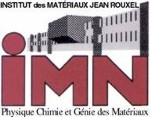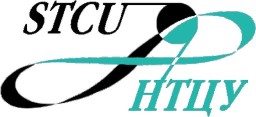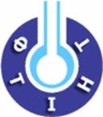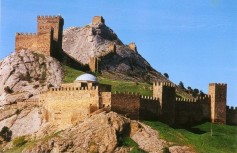
Frontiers
in Spectroscopy of Emergent Materials Sudak, Crimea, Ukraine, 14-18 september 2003 |
 IMN-LPC,
2 rue la Houssiniere F-44322 Nantes, France tel : 33-2-40373977 fax : 33-2-40373991 http://www.cnrs-imn.fr/ |  Science & Technology Center in Ukraine |  B.Verkin Institute for Low Temperature |
Dear Colleagues,
The NATO Advanced Research Workshop
Frontiers
in Spectroscopy of Emergent Materials: Recent Advances towards New Technologies
will
be held in Sudak (Crimea), Ukraine, 14-18 september 2003 (arrival 13 september,
departure 19 september).
http://science.allied-co.com/sciencecgi/cal.cgi?step=1&meet=arw
The workshop location is
http://www.toksudak.crimea.com/Sudak-e.htm
which is not far from the Simferopol International airport
http://www.ukraine-international.com/eng/index.html
The Workshop will take place in Sudak, a picturesque and original
Crimean corner located on the coast of Black Sea. Sudak and its vicinities are
rich in sights: Sudak Fortress, whimsical mountains, wild cliffs, mysterious
grottoes, verdure rare for the peninsula and variegated bays. The fortress in
Sudak built by the Genoese in the 14th - 15th centuries is one of the most interesting
monuments of medieval fortifications in Europe. The fortress is two-tier: the
lower tier presents a fortification wall with 14 towers, the upper comprises
the complex of fortification structures with the Consulate Castle. Even today,
especially after the reconstruction, it looks very impressive: |  |
The participations to ARW events proceed mainly
by invitation to ensure high-level contributions.
The workshop fee (for scientists
from industrial and commercial laboratories, and observers from non-eligible
countries) is 250 Euro. Accomodation and travel expenses at the lowest costs
may be granted partially (not for scientists from industrial and commercial
laboratories, and observers from non-eligible countries). Social program will
include excursions, etc.
Number of working days: 5, Number of participants: between 40-50
Objective: Comprehensive multidisciplinary consideration of the state-of-the-art of the contemporary spectroscopic research of emergent materials with different origin, structure, dimensionality and properties for progress in high-technological applications.
Organizing Committee: E.C. Faulques, D.J. Lockwood, D.L. Perry, I.K. Yanson, A.V. Yeremenko
Speakers and their affiliations:
Alexandr Anders, Kharkov National State University (Ukraine),
Metal-organic complexes of Cu(II): ground state and exchange interactions in magnetic subsystem
Philip Anfinrud, Laboratory of Chemical Physics, National Institutes of Health (Bethesda, USA), Watching a protein as it functions with picosecond X-ray crystallography
Eric Faulques, Institut des Materiaux Jean Rouxel, Universite de Nantes (France), Advances in ultrafast time-resolved spectroscopy of engineered molecular systems
Guirec Querre, Universite de Rennes (France), Spectroscopic methods in archaeometry
Victor Ivanov, Sofia University (Bulgaria), Scaled quantum force field: a promising approach to molecular vibrational dynamics
Gediminas Jonusauskas, Centre de Physique Moléculaire et Hertzienne, Université de Bordeaux (France), Development of tomography using femtosecond infrared lasers: imaging of biological tissues
Victor Karachevtsev, Institute for Low Temperature Physics and Engineering (Kharkov, Ukraine), Noncovalent funtionalization of single-walled carbon nanotubes for biological applications: Raman and NIR absorption spectroscopy
Vladimir Kurnosov, Institute for Low Temperature Physics and Engineering (Kharkov, Ukraine), Peculiarities of luminescence in systems with fullerene-water solutions
Serge Lefrant, Institut des Materiaux Jean Rouxel (Nantes, France), Raman and surface enhanced Raman scattering of nanotubes
Peter Lemmens, Max Planck Institute for Solid State
Research (Stuttgart, Germany), Optical spectroscopy of magnetic systems close
to quantum criticality
David Lockwood, Institute for Microstructural
Sciences, National Research Council (Ottawa, Canada), Progress in light emission from silicon nanostructures
Rimma Lyubovskaya, Institute of Chemical Physics (Chernogolovka, Moscow region, Russia), Molecular complexes of fullerenes as potential photoactive materials
Yuriy Malyukin, Institute for Single Crystals (Kharkov, Ukraine), Single J-aggregate spectroscopy
Esa Manninen, STCU (Kiev), General presentation of the Science and Technology Center in Ukraine
Miroslav Mensik, Institute of Macromolecular Chemistry (Prague, Czech Republic), Vibration-induced excited state decay problem
Philippe Moreau, Institut des Materiaux Jean Rouxel (Nantes, France), Progress on electron energy loss spectroscopy of nanomaterials
Ron Naaman, Weizmann Institute of Science (Rehovot, Israel), Photoelectrons spectroscopy of organized organic thin films
Joel Oswalt, Raman division, Jobin-Yvon SAS. (Longjumeau, France), Combined photoluminescence and Raman systems for microscopic analysis of thin wafers
Yury Pashkevich, Donetsk PhysTech Institute (Donetsk, Ukraine), Raman studies of single and polycrystalline rare-earth cobaltates
Dale Perry, Lawrence Berkeley National Laboratory (Berkeley, USA), Synchrotron spectromicroscopy and crystallography applied to advanced materials chemistry
Marina Popova, Institute of Spectroscopy (Troitsk, Moscow region, Russia), High-resolution infrared spectroscopy of low-dimensional magnetic systems
Eugene Sherman, RWTH (Aachen, Germany) and Karl-Franzens-University (Graz, Austria), Nanoscale spin-orbit coupling in two-dimensional Si-based structures
Lyubov Taranenko, Science and Technology Center in Ukraine (Kiev), Presentation of the STCU Partner Program
Evgeny Vinogradov, Institute of Spectroscopy (Troitsk, Moscow region, Russia), Spectroscopy of semiconductor microcavity polaritons
Igor Yanson, National Academy of Sciences of Ukraine, Advances in point-contact spectroscopy (diborides, etc.)
This list is not complete and will be of course
updated.
A deadline for abstracts (one page MS Word file, single spaced Times 12, typing area of 15x21.5) is June 5. Following the usual rules of the NATO ARWs the proceedings of the workshop will be published by Kluwer Academic Publishers as a volume in the NATO Sciences Series. Manuscripts will be collected and reviewed during the workshop. The participants are kindly asked for three hard copies of the manuscripts (including original figures) as well as the electronic version of the manuscript on a diskette in PC format (the preferred form is an MSWord file, although TEX files will also be accepted). The manuscript should be camera-ready according to the The papers presented as poster are assumed to be in the form of short communications of the original work with the total length of the manuscript (including the estimated place for figures) of 4 pages. In contrast the authors of oral contribution are requested to present review-type manuscripts with a total length of up to 12 pages. We agree with the publisher that the market for typical conference proceedings is limited, in contrast, editions of text-book or review character are of much more interest.
